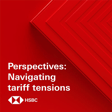Become a Creator today!Start creating today - Share your story with the world!
Start for free
00:00:00
00:00:01

Mind the gap, capturing CO2, and a new climate tool for central bankers - HSBC Global Research
Ashim Paun explains how it's possible to cut 81% of global emissions by 2050, Tarek Soliman looks at the opportunities for carbon capture, and Song Jin Lee sets out how some central banks are looking to help the net zero climate agenda. Disclaimer
To stay connected and to access free to view reports and videos from HSBC Global Research click here
Hosted on Acast. See acast.com/privacy for more information.
Transcript
Introduction to HSBC Global Viewpoint
00:00:00
Speaker
This is HSBC Global Viewpoint, your window into the thinking, trends and issues shaping global banking and markets.
00:00:09
Speaker
Join us as we hear from industry leaders and HSBC experts on the latest insights and opportunities for your business.
00:00:16
Speaker
Thank you for listening.
Introduction to ESG Brief Podcast
00:00:24
Speaker
Hi, everybody.
00:00:24
Speaker
Welcome to the ESG Brief, our podcast on the world of environmental, social and governance issues.
00:00:30
Speaker
From the perspective of the analysts here at HSBC Global Research, I'm Jack Reed, your host, along with Chris Brown-Humes, our managing editor.
The Path to Net Zero by 2050
00:00:39
Speaker
In the drive towards reducing carbon emissions around the world to net zero, what's so special about 81%?
00:00:45
Speaker
We talked to our co-head of ESG research, Asheen Pound, about what that number means in the context of his latest research.
00:00:52
Speaker
Energy analyst Tarek Solomon joins us to focus on two developing technologies.
00:00:57
Speaker
And we look at a new source of pressure to reorder global climate priorities, central banks.
00:01:02
Speaker
What role are they playing in the energy transition?
00:01:05
Speaker
We ask credit strategist Son Jin Lee.
00:01:08
Speaker
This podcast was recorded for publication on Monday, the 29th of March.
00:01:11
Speaker
Remember, all our disclosures and disclaimers associated with this podcast must be viewed on the link attached to the media player.
00:01:22
Speaker
Our first guest is Ashim Pown, climate change strategist and co-head of our ESG research team here at HSBC.
00:01:29
Speaker
Ashim has a new report entitled Future Frontiers, which is all about the pathway towards a net zero carbon emissions world by 2050.
00:01:37
Speaker
So just 29 years from now, in order to cap the rise in global temperatures.
00:01:43
Speaker
According to Ashim's report, if the world continues down its present course, global annual emissions are set to rise from roughly 50 gigatons of carbon dioxide today to nearly 90 gigatons in the year 2050.
00:01:56
Speaker
But Ashim also finds a way to cut those emissions by 81 percent, and he's here to tell us how.
Decarbonizing Power: Solar and Wind Focus
00:02:02
Speaker
Ashim, welcome.
00:02:03
Speaker
So how do we cut those emissions by 81%?
00:02:05
Speaker
81% is a big number.
00:02:08
Speaker
It's very ambitious.
00:02:09
Speaker
What we do in the report is to model for the contribution towards net zero that can be made by deep decarbonisation of four major emitting sectors, those being power generation, transport, buildings and industry.
00:02:25
Speaker
And in which of those sectors do you think there is most scope to cut emissions?
00:02:29
Speaker
So there's probably little doubt that the first sector, the first kind of focus for decarbonisation for most countries around the world is to look at their power generation, removing fossil fuels from how we generate electricity.
00:02:45
Speaker
and that's in particular removing coal, it gives you the most bang for your buck really.
00:02:49
Speaker
This is the most cost optimal way to reduce large amounts of greenhouse gas emissions.
00:02:54
Speaker
And indeed in some parts of the world, perhaps especially in Europe, we've seen
00:02:59
Speaker
increasingly deep decarbonisation of power generation as we do remove fossil fuels and replace them with low carbon alternatives.
00:03:07
Speaker
Solar power and wind turbines have become the energy transition story of this century so far, really, and that's been
00:03:15
Speaker
the main focus and continues to be because for many countries around the world, they're still using fossil fuels for a large part of their power generation.
00:03:24
Speaker
That's true across major emerging markets, but also in many developed markets as well.
00:03:29
Speaker
You see coal and natural gas being burned.
00:03:31
Speaker
So is it possible to cut power generation's emissions by 100 percent?
00:03:36
Speaker
To completely decarbonize power generation is a big ask.
00:03:40
Speaker
However, we have seen targets being introduced by large countries around the world to do exactly that.
00:03:49
Speaker
And indeed, in Europe, we do have some countries already which have zero carbon power generation.
00:03:53
Speaker
Norway uses hydroelectric.
00:03:55
Speaker
France is close to zero emissions from its power because of all that nuclear.
00:03:59
Speaker
And indeed, we've now seen Joe Biden talking about putting the US onto a pathway towards
00:04:06
Speaker
zero net emissions from its power generation by 2035, which is very rapid in the country which currently uses fossils for two thirds of its power generation.
00:04:15
Speaker
So although this is very ambitious, we think this is a major building block that needs to happen really if the world is to achieve net zero emissions by mid-century.
00:04:24
Speaker
And which of those sectors has the most scope to cut emissions?
Decarbonizing Transport and Industry
00:04:27
Speaker
Right, so we're also going to need a deep decarbonisation of many other parts of the economy if we're to get close to that mid-century target.
00:04:36
Speaker
We look at the different modes of transport which consume oil derivatives as their energy source,
00:04:42
Speaker
and plot different pathways for cars and trucks and ships and aviation and other sectors as well.
00:04:49
Speaker
For cars, we know that electric vehicles look like the most viable alternative to the internal combustion engine, but for trucks, maybe hydrogen can play a role in fuel cells as well as perhaps batteries.
00:05:01
Speaker
With ships and aviation, perhaps it's more complicated.
00:05:03
Speaker
There's other alternatives, including ammonia in ships perhaps.
00:05:06
Speaker
Now, with industry, it's a very, very diverse sector and it requires very disparate solutions.
00:05:12
Speaker
When we talk about decarbonisation of oil and gas production, of cement, of iron and steel and other non-ferrous metals, and also things like chemicals and plastics and fluorinated gases, many, many parts of industry, and they all require different solutions.
00:05:26
Speaker
We see, again, potential for hydrogen to play a role, to replace fossil fuels in heat generation, perhaps, and also perhaps for
00:05:35
Speaker
carbon capture and sequestration technologies to capture some of the carbon that come from industrial applications like steel making.
Decarbonizing Buildings and Sector Efforts
00:05:43
Speaker
And then lastly, buildings.
00:05:44
Speaker
I mean, buildings use fossil fuels directly within them, you know, burning natural gas within homes for heating and for hot water and for cooking.
00:05:52
Speaker
Similarly, oil is used, and to a lesser degree in some parts of the world is still coal, but also buildings use a large part of that power which we generate in the first place.
00:06:00
Speaker
And so if we have buildings that
00:06:01
Speaker
which are transitioned away from burning fossil fuels directly and which become more efficient in their use of electricity, the emissions from that part of the economy can come down as well.
00:06:12
Speaker
And so in combination, those four sectors with deep decarbonisation pathways, which we plot in the report,
00:06:18
Speaker
can in aggregate give us around an 81% closing of the gap between where the United Nations Environment Programme's business as usual scenario says we're going and down towards that net zero level by 2050.
00:06:35
Speaker
Ashim, that's a great place to end.
00:06:36
Speaker
Thanks very much indeed for joining us.
00:06:38
Speaker
Thank you, Chris.
Carbon Capture and Sequestration Solutions
00:06:40
Speaker
Two of the technologies that Ashim mentioned there that may help close the emissions gap, carbon capture and so-called green hydrogen, are the subject of our next guest, Tarek Solomon.
00:06:51
Speaker
Tarek is an energy analyst.
00:06:53
Speaker
He's a member of the oil and gas equity research team here at HSBC and a regular contributor to our research on the energy transition theme.
00:07:01
Speaker
Tarek, thanks for coming on.
00:07:03
Speaker
Thanks, Jack.
00:07:04
Speaker
Let's start with your big report last week on carbon capture and sequestration.
00:07:08
Speaker
What is it and how does it work?
00:07:10
Speaker
Well, you may not be surprised to know that it actually is what it says on the tin effectively.
00:07:15
Speaker
It's putting an industrial application to prevent as much of the CO2, in some cases up to 90 percent, of the emissions from an industrial or an energy intensive process and preventing them from getting into the atmosphere.
00:07:31
Speaker
So it's about capturing those carbon dioxide or CO2 emissions.
00:07:35
Speaker
Once that's captured, there are some ways for that to be put to use.
00:07:39
Speaker
But, you know, more likely than not, we see in the future.
00:07:43
Speaker
It's about taking that CO2 and basically finding a home for it for life, permanent storage or the word sequestration.
00:07:51
Speaker
So it's putting it into the typically secure geological formation.
00:07:55
Speaker
So, you know, rocks underground, perhaps a depleted oil field.
00:07:59
Speaker
where it'll stay for decades, if not hundreds of years, and effectively be locked away for good.
00:08:07
Speaker
You say in your report that we're in a make or break decade for carbon capture.
00:08:10
Speaker
What do you mean by that?
00:08:12
Speaker
Well, we phrased it that way because carbon capture is not particularly new.
00:08:16
Speaker
It's been around for a couple of decades.
00:08:18
Speaker
It's had a very stop-start journey.
00:08:21
Speaker
It's not had a lot of support from corporates and governments, you know, that sort of wind and solar paths have.
00:08:27
Speaker
And as a result today, it's on the peripheral of the energy system only captures a fraction of a single percent of global CO2.
00:08:36
Speaker
With all technologies, scales, costs, proof of concept, all important.
00:08:40
Speaker
And we think carbon capture needs to make significant progress on some of those in the 2020s to really serve as a platform for it to play a more meaningful role in the future road to net zero.
00:08:55
Speaker
I would point out, though, carbon capture sequestration, along with other technologies, for example, like green hydrogen, they're all part of a toolbox of options to get to net zero.
00:09:05
Speaker
Neither one of them individually is a silver bullet for the energy transition sort of issue.
00:09:11
Speaker
So how does carbon capture proceed at pace then?
00:09:14
Speaker
Well, it does need some help.
00:09:16
Speaker
I mean, what we've identified in the report is, we call it the five Ps.
00:09:20
Speaker
It's policy support, so governments effectively mandating its use.
00:09:26
Speaker
It's about attracting private capital, so getting the private sector involved in funding some of these projects rather than the public sector solely.
00:09:34
Speaker
It's about project costs, you know, getting that cost of capturing carbon down.
00:09:41
Speaker
pipeline prospects, so the projects we can see coming along that are, that we think are coming, actually get built, are de-risked and are shown to be successful.
00:09:50
Speaker
And finally, and perhaps uniquely about carbon capture, it's about perception issues.
00:09:55
Speaker
There's no point hiding behind the fact that the technology does attract some criticism
00:10:00
Speaker
as a way perhaps to sweep our problem under the carpet and continue the use of fossil fuels.
00:10:06
Speaker
So it needs to overcome that as well to be a more widely accepted part of the energy system in the future.
Green Hydrogen: Production and Challenges
00:10:12
Speaker
So carbon capture, one potential tool in the box.
00:10:15
Speaker
You've also looked at development of so-called green hydrogen.
00:10:18
Speaker
By that, we mean hydrogen produced in a process powered by renewable energy sources.
00:10:23
Speaker
What was your focus in that report?
00:10:25
Speaker
Yes, so we wrote about that back in January, and the real focus of the report was actually about the equipment that we need to make green hydrogen.
00:10:34
Speaker
So it's a process of cracking water molecules to produce hydrogen as a fuel source.
00:10:41
Speaker
And as you mentioned, if you do it with zero carbon electricity, you get zero carbon or green hydrogen.
00:10:48
Speaker
But you need the kit to actually make it.
00:10:50
Speaker
And, you know, up until now, that's been
00:10:52
Speaker
a pretty small and nascent industry and again symptomatic of quite a lot of the energy transition, it's got to go through a pretty big transformation in a relatively short period of time.
00:11:03
Speaker
And just to give you an example of that, the European Union has mandated a 400-fold increase in the installed base of these pieces of kit, electrolysers, by 2030.
00:11:14
Speaker
So that's less than 10 years, 400-fold increase.
00:11:17
Speaker
So having to have a whole industry almost
00:11:21
Speaker
borne out overnight.
00:11:22
Speaker
And again, I think you could argue that that's symptomatic of a lot of the energy transition.
00:11:27
Speaker
It's scale.
00:11:28
Speaker
And also, if we're talking about the broader issue of global warming, time and speed is also of the essence.
00:11:33
Speaker
So a big challenge to get the supply chain in place to help green hydrogen make its impact on the energy system.
Central Banks and Climate Change Initiatives
00:11:43
Speaker
Tarek, thanks very much for joining us.
00:11:46
Speaker
Thanks for having me, Jack.
00:11:48
Speaker
In normal times, central banks are associated with monetary policies like the setting of interest rates and inflation targets.
00:11:55
Speaker
But for well over a decade, central banks have adopted extraordinary measures to keep the global economy on track.
00:12:01
Speaker
And that could also be a new tool in the drive to tackle climate change.
00:12:06
Speaker
Our credit strategist Song Jin Lee is here to tell us about the greening of central bank bond buying programs.
00:12:12
Speaker
Song Jin, this is a fascinating topic.
00:12:15
Speaker
What are central banks doing in this space?
00:12:18
Speaker
Thanks, Chris.
00:12:19
Speaker
Before I answer the question, perhaps it's worth putting this into context.
00:12:23
Speaker
So over the last decade or so, central banks have been engaging in quantitative easing programs as one of the means to stimulate the economy.
00:12:32
Speaker
At the start, they were buying mostly government bonds, but over the last five years or so, they have started to buy corporate bonds as well, which means central banks are now significant owners of these instruments.
00:12:47
Speaker
And as a result, they have been coming under increasing pressure from both the public and governments to consider how their corporate bond holdings are aligned with the Paris Agreement.
00:13:00
Speaker
What are specific central banks doing with their bond buying programs?
00:13:04
Speaker
Well, at the start of the year, the Swedish central bank, the Riksbank, has...
00:13:09
Speaker
began employing a form of negative screening to its corporate purchases.
00:13:14
Speaker
So what does that mean?
00:13:16
Speaker
It means it looks at the list of eligible companies and it avoids buying the bonds of companies who do not meet their internal ESG standards.
00:13:26
Speaker
Now, if you look in the UK, the Bank of England has pledged that to align its corporate bond holdings with a net zero future.
00:13:35
Speaker
In other words, its corporate bond QE program should be broadly aligned with the UK government's climate goals.
00:13:44
Speaker
But of course, these two European central banks are comparatively quite small to the elephant in the room, by which I'm referring to the ECB's
00:13:53
Speaker
266 billion euro corporate bond purchase program, the so-called CSPP program.
00:13:59
Speaker
And we think that right now the ECB is going through a strategic review and it will decide by the second half of this year what to do with its own corporate QE program.
00:14:10
Speaker
You've just published a report about the ECB.
00:14:13
Speaker
What are you expecting to hear from them?
00:14:17
Speaker
So our green bond strategist has explored all the options that are available to the ECB.
00:14:22
Speaker
But we think the most likely policy option they would take is to adjust their purchases, but differentiate between companies instead of between sectors.
00:14:33
Speaker
And the main reason we think that's the case is because
00:14:37
Speaker
We don't think the ECB wants to be accused of straying too far into the realm of industrial policy by starting to direct money or capital between industries because traditionally it is the fiscal authorities, the governments that have done that.
00:14:53
Speaker
So they rather keep the allocations to each sector, maintain it as the same, but then differentiate between the dirty and clean companies within each sector instead.
00:15:06
Speaker
And what's the timetable and what do you expect the impact to be on the corporate bond market?
00:15:12
Speaker
So the ECB hasn't announced a specific timeline for this, but we think that an announcement at some point in the second half of this year is quite likely.
00:15:23
Speaker
When it comes to market impact, well, upon announcement, we do think that the interest rates for some of the dirtiest companies within Europe might well rise as the ECB signals that it plans to reduce purchases of their bonds.
00:15:37
Speaker
And that is part of the desired impact.
00:15:41
Speaker
By increasing the cost of capital for the dirtiest companies, they can help redirect their capital towards the cleaner companies and help facilitate this transition.
00:15:52
Speaker
towards a net zero.
00:15:54
Speaker
Song Jin, thank you for joining us.
Conclusion and Other Research Themes
00:15:57
Speaker
Thank you.
00:15:58
Speaker
So that's all we have time for today on the ESG Brief.
00:16:02
Speaker
Special thanks again to Ashim Pan, Tarek Salomon and Song Jin Lee.
00:16:07
Speaker
The energy transition that we talked about today is one of nine big themes covered by our team of analysts here at HSBC Global Research.
00:16:15
Speaker
The other themes in the stable for 2021 and beyond are automation,
00:16:19
Speaker
digital finance, disruptive technology, future cities, the future consumer, future transport, and lower for longer interest rates.
00:16:27
Speaker
You can find out more about all of those themes as well as the reports that we touched on today on the research website at research.hsbc.com.
00:16:36
Speaker
From Chris and me, thanks for listening.
00:16:38
Speaker
We'll be back soon.
00:16:45
Speaker
Thank you for listening today.
00:16:46
Speaker
This has been HSBC Global Viewpoint, Banking and Markets.
00:16:50
Speaker
For more information about anything you heard in this podcast or to learn about HSBC's global services and offerings, please visit gbm.hsbc.com.
















